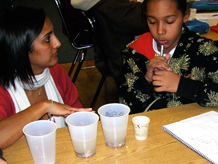What happens to shells when we crush them?
4. Make meaning
Purpose of the discussion
The purpose of this discussion is to construct an explanation of what happens to the volume and weight of shells when they are transformed through crushing. The students’ explanation should be consistent with their observations and evidence . They also connect their shell crushing experience with the phenomena of weathering. Return to the investigation question for discussion.
Engage students in the focus questions

Students go out on a limb when they make a prediction and they are usually interested in the outcome of their data collection. When their predictions are not supported by data, some are willing to rethink their ideas based on these findings while others are reluctant to let go of their original ideas. Ask students to compare their predictions and the class data (refer to the group data table).
What happened to the shells when you crushed them?
- When you look back at your predictions, do any of these findings surprise you? Why?
Help students find relevance in today's investigation.
- How would you connect today’s findings to weathering in the natural world?
Listen for ideas about how shells are weathered by tides pushing them along on the shore, rolling them against each other, breaking off pieces here and there, and distributing the smaller pieces on the beach or in the waves. The shell weathers but it doesn’t go away; the smaller pieces just become more spread out across the beach and ocean floor.
Weight and volume stay the same: Unless some pieces of shell are lost in handling, crushing the shells will not result in a change of weight or shell volume. The bulk volume of the shells, on the other hand, is likely to become smaller. Although students will not measure bulk volume, you may wish to remind them of the concept and ask what they think has happened to bulk volume.
Point out that the plastic bags represent Earth. As shells and rocks and soils weather, the pieces get smaller and smaller but they are still on Earth — just as the shells remained in the bag after the students crushed them. The Earth does not lose any material when a shell is turned into dust; the material is transformed into something different, but no material is lost from Earth. The earth materials you see today will be here forever in some form or another.
Provide time for students to make claims in their notebooks [Crushing shells claims].
Summarize the discussion and recap the investigation
Summarize the discussion by having several students share (from their notebook) their claims, evidence, and explanations for what happens to shells when we crush them.
As you wrap up today's investigation, check for a beginning understanding of the following points:
- When an object is transformed, some things stay the same and other things change.
- When earth materials become weathered, they do not disappear; they keep their weight and volume but get spread out over a greater area.
- Earth is made up of a finite and constant amount of material.



